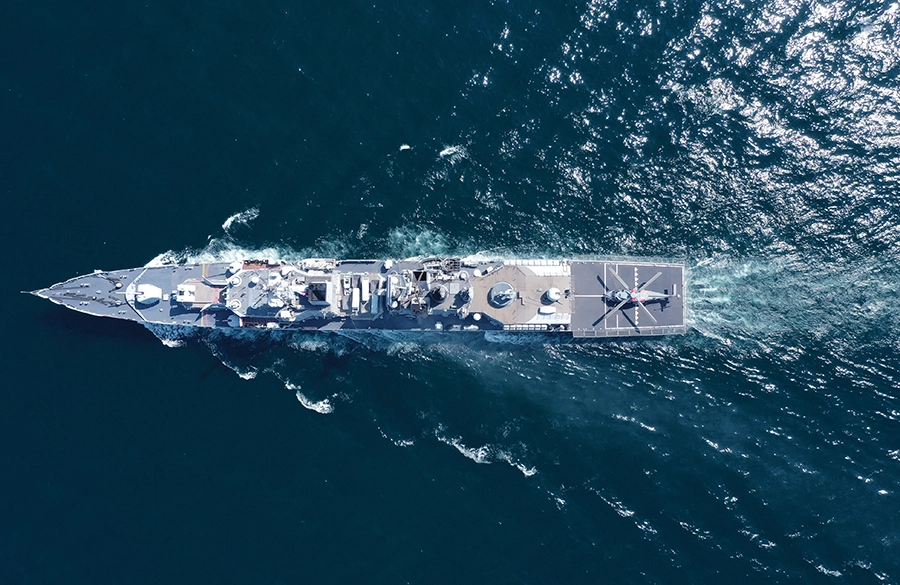Recently, I had the extraordinary experience of spending a day and a night at sea in the Pacific Ocean on board the USS Nimitz. I was part of a Navy outreach program to give ordinary landlubbers like me a perspective on the mission and operations of a naval strike group.
I was excited. Who would turn down a chance to get on top of a nuclear power plant driving 100,000 tons of steel through the ocean, with 5,000 men and women handling scores of aircraft, carrying thousands of pounds of bombs and missiles, burning thousands of gallons of jet fuel a day, with margins measured in inches, and tolerances of seconds?
What I discovered during my visit is that many of us who are working in non-military organizations, and who may not have given a second thought to the Navy as a model, would do well to understand how a small city floating on the ocean works. During about 30 hours of immersion with sailors and pilots (and public affairs officers), I realized there were several principles at work that make the Navy so successful — principles that are not at all unique to running an aircraft carrier — representing important lessons for everyone interested in entrepreneurship, innovation, teamwork, and management:
1. Inspiration: Having a big, meaningful goal is a tremendous force for inspiration, motivation, and cohesion. The Navy’s mission is not some vague, abstract, feel-good paragraph in a business plan; it is very concrete, and very easy to understand and internalize. In addition to defending America, fighting terrorists, and rescuing victims of piracy, the Navy takes enormous pride in their role in helping the tsunami victims in 2004, and in helping the Katrina victims in 2005. While everyone I talked with had his or her own particular story, everyone had a distinct and powerful pride in what they had accomplished and in the people around them. Even in the best organizations, in my experience, such a core consistency of pride is extremely rare.
2. Perspiration: If everyone buys into the goal, you can get an amazing amount of work done, including regular 16-hour days with very low pay. The Nimitz does not offer a 9-to-5 workday. Some days, crews are on the flight deck for 14 or 16 hours, into the wee hours of the morning, inhaling noxious fumes and making sure every plane gets back safely. And then after the planes get back at midnight, the maintenance crew is still at work making sure the planes are ready for the next day. A maintenance chief told me that, given the age of the planes and the stress of carrier flying, it is typical that a plane requires 25 hours of maintenance for every hour of flight time. That seems inefficient, but the alternative is unacceptable. You don’t want to fly a plane that is anything less than 100% maintained.
3. Teamwork: As much as the movie “Top Gun” created the impression that it’s about competing to be No. 1, the ethic in an actual operating situation is intensely about team performance. Watching the crews maintain, fuel, setup, and pilot F-18s for flight, it’s clear it’s not about who’s the hottest dog on the deck. Every single person counts on other members of the team to enable them to get their part of the job done, and no one person can take credit for success, or benefit from another’s failure.
4. Recruiting and training: There is a common misperception that the military attracts the lower performers in our society who have no other choices. The Navy is very fortunate to have more people who want to join than there are available slots. But more important, the men and women who make it through training are astoundingly competent people. The lesson here is that it’s not about fancy degrees and prior polish; it’s about a commitment to excellence in each individual, and the willingness to work to exhaustion to make sure you live up to your commitment.
5. Accountability and continuous improvement: There is no contradiction between an intense ethic of teamwork and the need for individual accountability. In the Navy, everything is monitored and measured. Every system has to perform at 100%, and for every system there is a person responsible for making sure that happens. Every cycle of take-offs and landings is measured and scored. And every score is assessed to figure out a way to do it better. 
6. Respect: In the Navy, if you don’t like someone because of their race, or creed, or whatever, you have the opportunity to change your mind, because that person may be living in the bunk 14 inches away from you. Respect isn’t just an altruistic ethic; it’s a necessity. More so than any other institution, the U.S. military has been successful at integrating America’s young men and women. I’m sure the Navy is not perfect in this regard, but when I looked around the bridge and saw the incredibly diverse team of men and women who were calmly, confidently, and competently running this multi-billion dollar acme of American technological accomplishment, I thought why can’t all of America be more like this?
7. Overcoming fear: On a busy aircraft carrier, there are a lot of things that happen that are really scary, and people die. Despite the macho prototype of the Navy pilot, in private these pilots admit that landing a jet on a moving carrier at night is a downright terrifying experience. Watching a series of jets land at night, you get the impression that it must be pretty easy, because they do it so well. But it isn’t easy; and even with years of practice and experience, it’s nerve-wracking.
8. Work/Life balance: It’s hard to imagine how people in the military handle being away from their families for months at a time, in environments that are almost entirely work. It’s clear that it is not easy for most. My impression is that the Navy tries to ease the strain by creating a work environment that is much looser and more casual than we expected. We thought the crew aboard the ship would be much more heavily starched than they were, and that the interactions between subordinates and superiors would be much stiffer. When you are on the line, there is no slack, and there is no room for anything less than 100%. But when there is a break in the action, you can relax and be human.
9. Reverence and irreverence: The week before our visit, the Nimitz lost five crew in a helicopter accident. These were not strangers; these were co-workers and friends. Among the pilots, it seems that everyone has at least one story of a good friend who was lost. For these men and women, death is all too real. There are memorials around the ship to remind everyone of those who have given their lives in the service of their country. At the same time, there is an irreverence that pops up quite frequently, sometimes when you wouldn’t expect it. The captain, in welcoming us, referred to the aircraft carrier as being “kind of like a jail, except there’s the possibility of drowning.” Not exactly what you would expect to hear.
10. 100% performance: From moment to moment, the operations on board a nuclear aircraft carrier expose the crew to an extraordinary degree of danger. A simple mistake can result in death, and much of what is being done on the ship and in the air is not at all simple. But they make it look simple. We watched scores of planes take off and land on a moving platform without a hitch. The key is training, training, training, and total focus and dedication when you are on the line.
Not every entrepreneur wants to model his or her organization and culture on the Navy. For many entrepreneurs, indeed, that is a very unappealing concept, but that’s because they don’t really understand what makes the Navy one of the most effective organizations on the planet. Like any other successful organization, it’s about the people. The key is harnessing the incredible potential of every individual through inspiration, training, and teamwork.
Guy Kawasaki is the chief evangelist of Canva and the creator of Guy Kawasaki’s Remarkable People podcast. He is an executive fellow of the Haas School of Business (UC Berkeley), and an adjunct professor at the University of New South Wales. He was the chief evangelist of Apple and a trustee of the Wikimedia Foundation. He has written Wise Guy, The Art of the Start 2.0, The Art of Social Media, Enchantment, and eleven other books. Kawasaki has a BA from Stanford University, an MBA from UCLA, and an honorary doctorate from Babson College.



